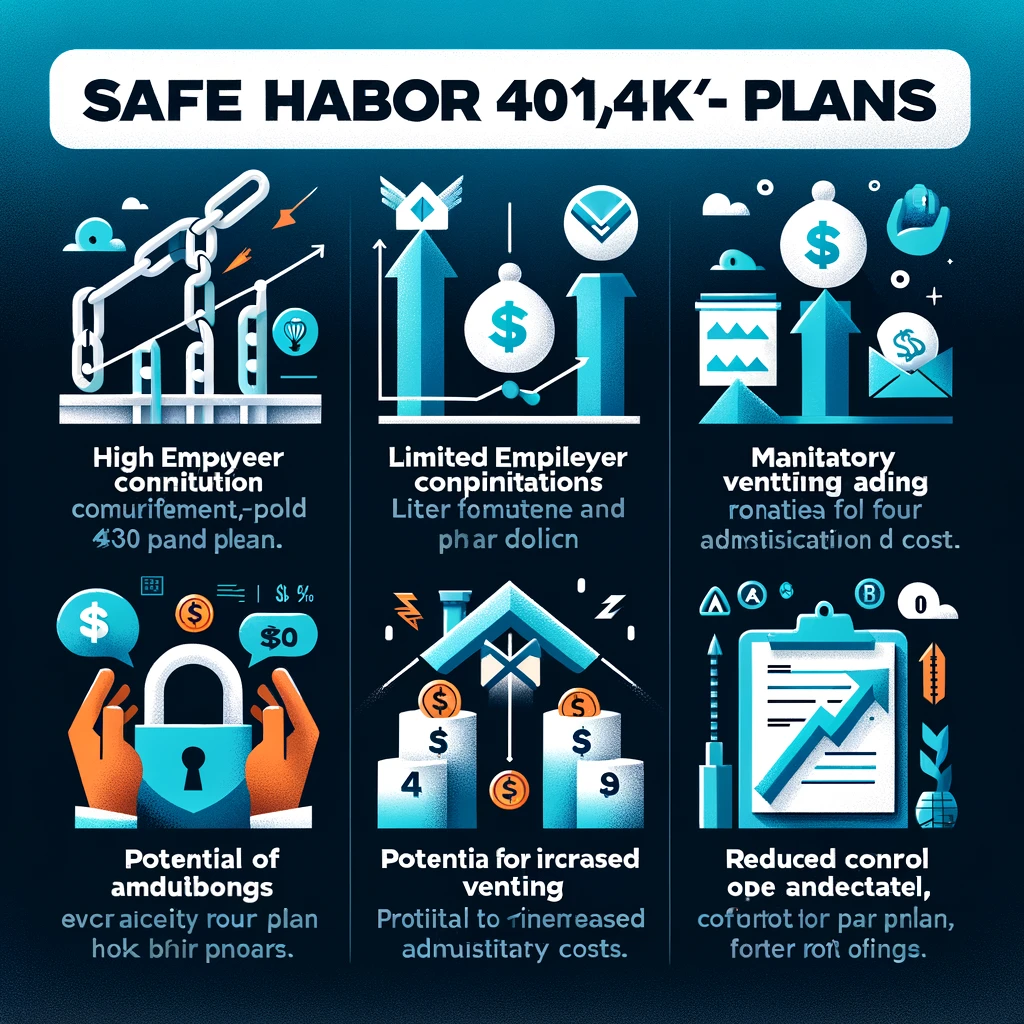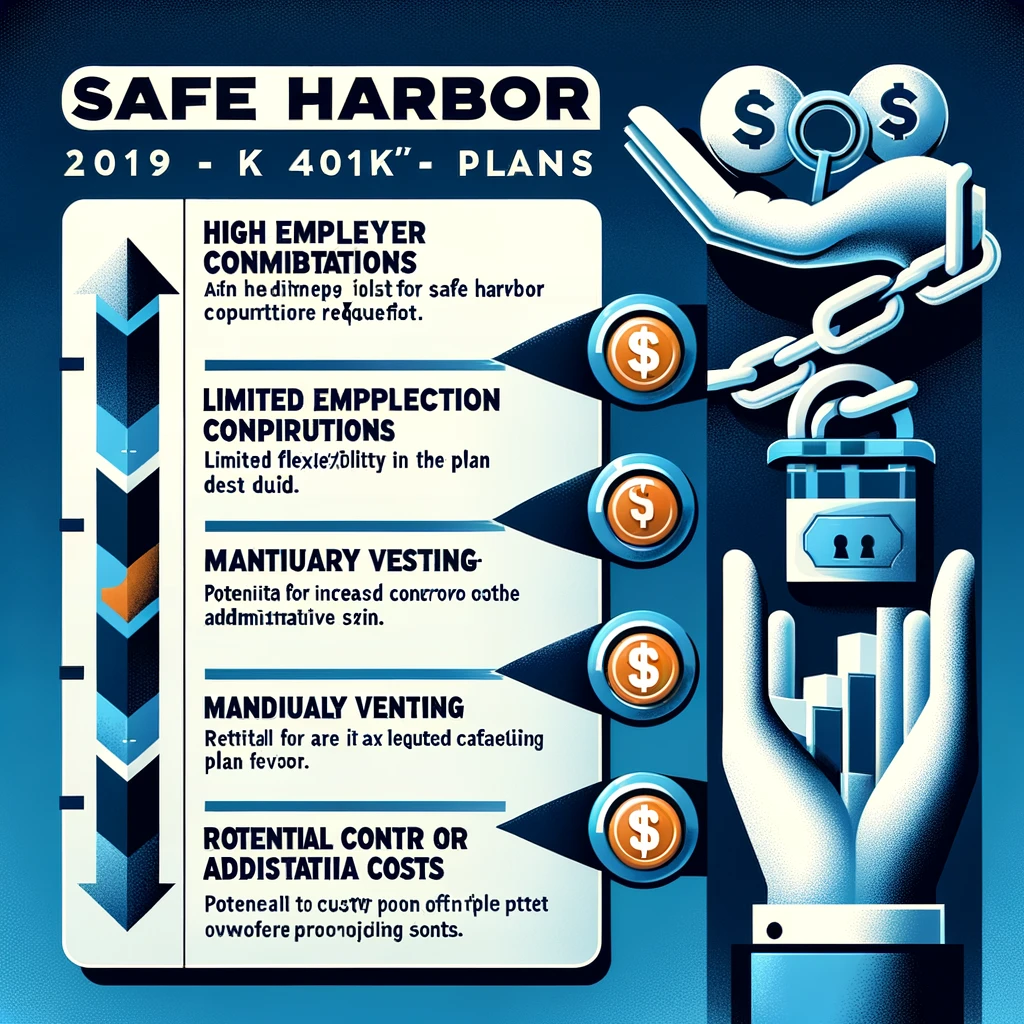Explore key disadvantages of Safe Harbor 401k plans. From limited flexibility in contributions to potential lack of investment options, understand the limitations before making a decision.Safe Harbor 401(k) plans are designed to encourage small businesses to offer retirement benefits by simplifying some of the non-discrimination testing requirements.
Disadvantages of Safe Harbor 401k You Must Know.

Here’s a table summarizing the disadvantages of Safe Harbor 401(k) plans:
| Disadvantage | Description |
|---|---|
| Mandatory Employer Contributions | Employers must make either a matching or non-elective contribution to employees’ accounts, leading to increased financial commitment. |
| Limited Flexibility | Strict rules about contributions and notices reduce the ability to tailor plans to specific business needs. |
| Increased Administrative Burden | Compliance with notice requirements and ensuring accurate contributions add to the administrative workload. |
| Vesting Schedules | Immediate vesting of Safe Harbor contributions might limit employer’s willingness to make additional, vested contributions. |
| Less Discrimination Testing, but Not Eliminated | Safe Harbor plans simplify some testing but do not eliminate all non-discrimination testing requirements like the top-heavy test. |
| Higher Costs | Mandatory contributions and administrative expenses can make these plans more costly than traditional 401(k) plans. |
| Less Incentive for Employee Contributions | Guaranteed employer contributions might reduce the incentive for employees to contribute themselves. |
| Complex Withdrawal and Loan Rules | Safe Harbor 401(k) plans are subject to complex federal rules on withdrawals, loans, and distributions. |
| Business Circumstance Changes | If a business’s financial situation changes, maintaining required contributions can be challenging. |
| Risk of Non-Compliance | Failure to meet Safe Harbor requirements could lead to loss of status and subject the plan to standard non-discrimination testing. |
1. Limited Flexibility in Contributions
Unlike traditional 401(k) plans, Safe Harbor 401(k) plans impose strict contribution requirements on employers. They must either match employee contributions up to a certain percentage or make a non-elective contribution on behalf of all eligible employees. This lack of flexibility can be a disadvantage for employers who may prefer more control over their contributions.
2. Higher Cost of Administration
While the simplicity of Safe Harbor 401k plans is often touted as an advantage, it comes at a cost. The administrative fees associated with these plans can be higher compared to other retirement options. Small businesses may find it particularly challenging to bear these additional expenses, especially if they have a limited budget.
3. Lower Employee Contribution Limits
Safe Harbor 401k plans have the same contribution limits as traditional 401(k) plans for employees. However, they generally don’t offer the option for catch-up contributions for employees aged 50 and above. This limitation can be a disadvantage for older employees who may want to maximize their retirement savings as they approach retirement.
4. Reduced Flexibility in Plan Design
While Safe Harbor 401k plans provide simplicity in terms of administration, they also limit the flexibility of plan design. Employers may find it challenging to tailor the plan to suit the specific needs and preferences of their workforce. This limitation can be a disadvantage for organizations that wish to offer unique benefits or incentives to their employees.
5. Required Notices and Disclosures
One of the requirements of a Safe Harbor 401k plan is to provide employees with timely notices and disclosures about the plan. Employers must ensure compliance with these requirements to avoid penalties. This additional administrative burden can be time-consuming and may distract employers from focusing on other aspects of their business.
6. Potential for Inequality Among Employees
Safe Harbor 401k plans require employers to provide equal benefits to all eligible employees, regardless of their income levels or positions within the company. While this may seem fair on the surface, it can inadvertently create inequality among employees. High-earning employees may feel limited by the contribution limits imposed on their savings, while lower-earning employees may see fewer benefits compared to other retirement savings options.
7. Limited Roth Contribution Options
Roth contributions offer tax advantages for retirement savings. However, Safe Harbor 401k plans have limitations on Roth contributions. Employees who prefer the tax-free growth potential of Roth savings may find this to be a disadvantage of these plans.
8. Potential Impact on Highly Compensated Employees
Safe Harbor 401k plans are designed to ensure that highly compensated employees (HCEs) maintain favorable contribution levels by meeting certain requirements. However, these requirements may still limit the contributions HCEs can make to their retirement savings, which can be a disadvantage for employees who aim to maximize their retirement benefits.
9. Potential Loss of Flexibility for Employees
While Safe Harbor 401k plans provide some benefits, they may not offer the same degree of flexibility as other retirement savings options. Employees who prefer to have control over their investment choices and diversification strategies may find this to be a disadvantage of these plans.
10. Lack of Investment options
Safe Harbor 401k plans often have a limited number of investment options compared to other retirement savings alternatives. This can restrict employees’ ability to create a well-diversified investment portfolio tailored to their risk tolerance and retirement goals.
In conclusion, while Safe Harbor 401k plans provide certain advantages, it’s essential to understand their limitations and potential disadvantages. Employers and employees should carefully evaluate their retirement savings needs and consider alternative options to make an informed decision that aligns with their financial goals and preferences.
